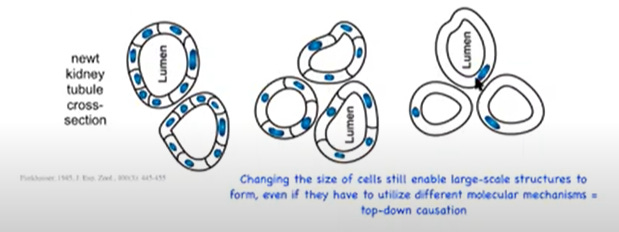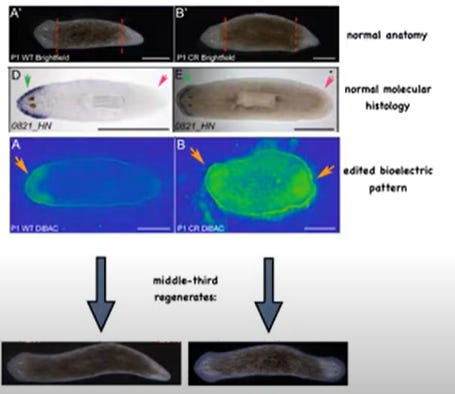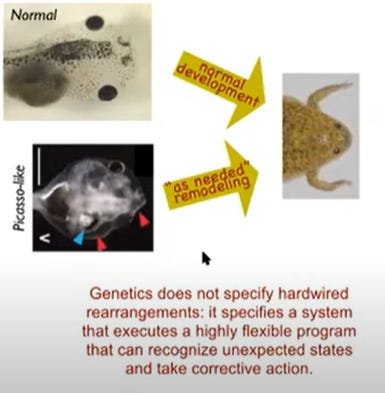Before we mapped the human genome we assumed that DNA would hold the instructions of where body parts should be placed within the body. But, once the mapping had been undertaken, we realised that DNA only contains the instructions of how to build the proteins in your body, not where those parts end up.
Furthermore, how does your body know when to stop growing? Why did your finger stop growing where it did, rather than being a foot long or stumped at the knuckle? Why does the liver regenerate whilst other body parts don’t? Why do children’s fingertips regrow if cut off but this ability stops after a few years?
As identical cells multiply and grow into animal bodies’ amazing anatomy, we usually think it's molecules dictating complexity. But what if the cells themselves show intelligence - shared goals and skills enabling their incredible cooperation? This radically different idea comes from pioneering developmental biologist Mike Levin's fascinating research frontier.
Levin heads an interdisciplinary group at Tufts University, Massachusetts spanning computer science, engineering and philosophy. They suggest cell groups work as a collective intelligence, displaying all the features of “mind” enabling their goal-focused navigation and problem-solving in anatomy. Levin terms this purposeful space “morphospace” – all the anatomical shapes cells work together to build, from embryo organs to regeneration replacing damaged body parts.
Levin explains that we really need to understand how cell groups know what to construct and when to stop. Regenerative medicine specialists would like to know how to get cells to rebuild missing structures. And engineers would like to figure out what else could they could get the same cells to create. He pictures an Anatomical Compiler that could someday decode any body blueprint into the bioelectrical signals organising cells to sculpt it.
This requires viewing cells less as programmed robots and more as flexible collectives with skills nearing what we think of as cognitive. But accepting cells' shared intelligence, creating order from disorder, means rethinking assumptions on embryo development.
Beyond Just Genes and Emergence
The current view is genes provide cells basic parts and interaction rules. Then, intricate structures emerge bottom-up as simple pieces self-organise. For instance, genes direct cells to produce signalling molecules forming gradients determining body orientation and cell layers. This neatly explains how identical modular units (cells) construct bodies by self-assembling based on local interactions.
However, Levin argues while that seems straightforward on paper, the real process has more shades of agency. Embryos reliably adapt if early cells move or disappear, still forming normal structures. Late stage patterning also self-fixes some flaws. This shows cell groups can sense deviation from anticipated states and actively minimise disorder.
In other words, anatomy isn’t just emergent but controlled - hinting at in-cell intelligence chasing set goals. It isn’t just a one-way cell construction of structures from genetic code. Rather, cells appear to cooperate toward an ideal end shape.
This concept has great potential use – unlike just patching low-level cell behaviours, controlling anatomical setpoints could enable us to direct regeneration after injury or even make cell groups build entirely new shapes. But first it needs proof of principle – can intelligence be assigned to cell groups and if so, how is it stored? That leads us to a key discovery of cellular cognition.
Cracking The Bioelectric Code
A clear sign of intelligence is reaching the same result through alternate routes when obstacles arise. Individual cells demonstrate this ability. For instance, they can alter their molecular strategy to still construct normal kidney tubule structures despite atypical conditions like DNA copy errors changing their size. So Levin defines intelligence as effectively navigating to solve problems and improvise.
The question becomes how do large cell groups embody that navigational capacity. For example, what links the skin cells that push a lever to get food with the gut cells rewarded with sugar to form memory connections in a rat? Levin realised beyond self-organised emergence, cellular swarms must have coordinating circuits that bind dispersed members into one agency.
Fortunately, biology long ago evolved conductors enabling distributed cell groups to collectively process information and respond – bioelectrical networks. Ion channels and gap junctions allow cells to influence each other’s voltage potential and directly swap signals. The brain later hijacked such electrical synapses for its own developed role – directing body movement through space by muscle control.
In this view, even before nerve systems, early minds already tackled problems using bioelectricity and chemically-gated ion flows – navigating challenges in realms like anatomy, physiology and gene regulation. Evolution later built on ancient plug-and-play cell collectives as modular components to scale intelligence to far more intricate levels.
This realisation led Levin’s team to pioneer techniques visualising and editing cells’ endogenous bioelectric chatter. They revealed bioelectric states reliably foretell the eventual organ locations in embryos. This prompted an almost mind-bending hypothesis - what if bioelectric gradients aren't just predictive correlates of growth but actually encode anatomical goals and setpoints? Could purposeful alteration grant the long-sought anatomical control dial?
Rewriting The Body
The key bioelectric reprogramming involved introducing specific ion channels that override cells’ native electrical states. For example, in a developing frog embryo, cells that would normally become gut tissue have a different bioelectrical state than facial organ precursors. By inserting ion channels imposing an eye organ’s characteristic bioelectric pattern, the experimenters reprogramed those gut cells to now develop into a functional eye where one would never form. This reveals groups of cells can interpret physiological instruction directing anatomy.
Planarian flatworms usually regenerate a precisely normal single head when cut into fragments. However, manipulating the bioelectric gradients in a fully intact one-headed worm edited its physiological set point to encode a two-headed anatomy. Later cutting this worm caused the fragment to regenerate two heads instead of one. Showing enduring impact, this aberrant memory persisted after removing the abnormal head, indefinitely regenerating two heads when repeatedly cut despite having a completely normal genome.
The frog embryo work involved creating substantially deformed “Picasso” tadpole faces, with eyes, nostrils and jaws in utterly abnormal positions. Shockingly, they still self-corrected this severe developmental corruption to become entirely well-proportioned frogs. This again demonstrates intelligent cellular collectives perceiving and actively minimising defects between current and goal states to restore a target morphology.
Together, these dramatic results confirm bioelectric cues encode “anatomical memories” providing set points for regeneration and development – enabling cellular cognition navigating possibilities in the space of body forms.
Beyond controlling regrowth after injury or birth defects medically, this cellular reprogramming ability also provides bioengineering opportunities. Levin’s lab created Xenobots – new synthetic creatures solely formed from frog embryo skin and heart cells. Freed from in vivo constraints, these cell groups self-organize and display striking behaviours – coordinating movement to push pellets or replicate by gathering single cells into new Xenobots! The emerging lifecycle has no evolutionary history inside frogs, uncovering hidden potential of innate bioelectric goal-seeking within versatile cellular swarms.
A species' DNA provides cells with a basic toolkit of abilities that evolution gradually accumulated over generations. However, genes alone do not determine the enormous variety of anatomical structures that actually emerge from development and regeneration. Instead, complex body shapes are guided to a great extent by bioelectrical landscapes - patterns of electrical signalling and voltage gradients that cell groups collectively traverse. This coordinated cellular bioelectricity serves as a physiological memory system, enabling cells to morphologically problem-solve by teamwork.
So while genes supply modular skills, goal-directed navigation of creative possibilities arises from multicellular cognition – a distributed intelligence of bioelectrically coupled cell collectives that facilitates complex self-organisation. Rather than just genetics or emergence, flexible yet reliable development and repair of anatomies reflects somatic cognition built from cellular cooperation mediated via shared electrical communication.
Philosophy Into Discoveries
Stepping back, Levin stresses that genuinely testing scientific predictions requires framing conceptual frameworks into defined experimental spaces to query nature.
This echoes what pioneering computer scientist Alan Turing did when revolutionising programming in the 1940s/50s. Previously, changing system behaviour meant altering physical circuits, like using a soldering iron to swap office software. In contrast, Turing’s visionary leap conceived computation in terms of informational layers – separating underlying hardware from more flexibly controlling software executions.
Levin thinks a similar change is crucial to go beyond the slow step-by-step advances in modern molecular biology. The approaches that incrementally adjust low-level parts like genes and proteins strangely echo how computer science was before software abstraction enabled huge capabilities. However, seeing cells as groups collectively solving anatomical problems via bioelectrical coordination could prove a transformational shift in thinking. Just as conceptually separating software from hardware limitations created whole new industries, broadly grasping physiological software has the potential to usher breakthrough progress in medicine by rationally tapping cells' inherent intelligence.
The Notion of Self
Levin’s work raises profound questions around the nature of identity. Embryonic development starts as a single cell that divides into identical copies. When do those cell groups conceptually become one entity – an individual with anatomical ownership? The answer seems linked to alignment of collective goals. Cells perceiving shared bioelectrical fields now orient behaviour toward unified outcomes rather than individual agendas. In this way, bioelectrical coupling enables emergent selves – binding dispersed cell components into bodies.
Additionally, the loss of a collective identity seen in cancerous cells can be reversed. Experiments show that tumour cells forced to electrically interact with their normal neighbouring cells suppress the tumour cells’ out-of-control replication. This causes the errant cancer cells to resume cooperative roles supporting normal healthy bodily function, rather than pursuing selfish aims like endless growth.
The contours of this group identity appear remarkably fluid over time. Dividing early frog embryos into halves, the separated parts independently organise as distinct organisms before re-fusing. This demonstrates the ease by which cellular coalitions partition, highlighting indistinct borders between an embryo and its external environment. Similar fluidity likely applies to boundaries between multicellular bodies and broader ecological collectives incorporating microbial partners.
Moreover, the scale of consequences considered in unified physiological goals drastically impacts ethical behaviour towards subsidiary components. A human may willingly sacrifice skin cells climbing rocks to achieve enjoyable outcomes. To those damaged cells however, such trauma reflects nightmarish destruction, disconnected from inaccessible higher benefits. Understanding participation in multicellular collectives thus represents a profound philosophical challenge.
The Future of Controlled Morphogenesis
Essentially, Levin’s highly creative work uncovers embryogenesis’ hidden anatomical goals. This shows life has far greater inherent capabilities than we realised. If we can master the signalling techniques cells use to direct development, it may allow new degrees of control over anatomy. Levin envisions computationally translating visualised body plans directly into bioelectrical protocols that cellular groups use to produce targeted body shapes.
The prospect of precisely writing anatomy has fascinating implications – both medically beneficial and perhaps ethically concerning. In any case, harnessing life’s inner creative power represents a pivotal milestone in understanding and interfacing with cognition across all life forms.
What started as yeast has risen into bodies endlessly changing shape across evolutionary eras, progressively opposing the natural pull towards disorder. All sustaining order emerges from living systems, each having layered goals that bind cells into collective thinkers. And if an endless continuity of mind reveals itself even in small pieces, that suggests a vast universal consciousness underlies all things.








While this fascinating research might look astounding to laypeople and even specialist scientists who mostly have no clue or personal experience in holistic intelligence, this is old news for people who are in holistic tune with the universe, either through advanced spiritual practice or the intentional wise use of psychedelics, or both.
Groups of cells working together in an intelligent way? Why is that a surprise? Of course, they do . These idiotic arrogant specialist scinetists who think their little brain and education is the pinacle of intelligence in the universe, think it is a big deal and immedialty want to meddle, manipulate and control it, thinking they can improve and direct this intelligence.
It is like an ant trying to influence and improve on the interplay of galaxies. Little do they know that groups of cells working together intelligently is just a tiny part of the whole. EVERYTHING in the universe works together with this love-saturated incredible intelligence that humbles every human brain in immediate total submission and bliss when experiencend.
Only scientist that know this, should be allowed to practise. Everyon else will fuck it up, no matter how good the intentions are.
Here is a vague analogy. Imagine a highly sophisticated computer code regulating subway traffic in a big city. Then you let a computer kid play around with it, alter little parts of the code, experiment with it and see what happens. What can go wrong? Universal intelligence is a trillion time more complex - how else could the whole universe work together so magnificantly and stay in balance? Except for humans, of course.
It is very interesting that the researchers raised the question of "when the groups of cells intelligently working together" start the switch to become an individual entity. How stupid are you? Never, of course. This is an entirely false and exclusively human misconception. In reality, there are no individual entities. EVERYTHING is a network, part of an intelligece network affecting and influencing each other, from cells to galaxies.
It should be compulsory for everyone to do intentional, guided pyschedelic sessions to see it with their own eyes. Nothing would change humanity to the better than understanding this.
We once did. It was called living in paradise. Then something terrible happened. We got seperated from it and started to believe we are individual entities. And all suffering began.
The good news is, that this sense of seperation is not a hardwired real thing. It is an illusion in our minds and unreal. It can be undone and has been undone by countless mystics. This is the only goal worth pursuing. Everything else is moving deckchairs on the Titanic.
whole idea of seing ours being an individual
Truly key questions about the infinite intelligence behind the human anatomy and its connective messaging.